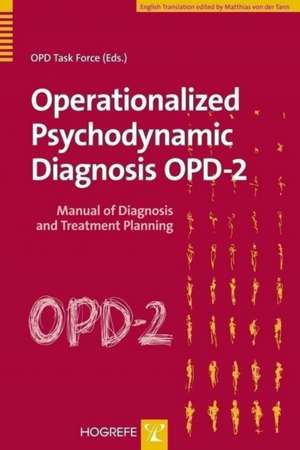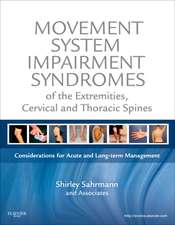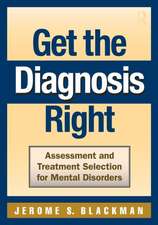Recenzii
From the Foreword:"Both systems [DSM-IV and ICD-10], however, in their effort to simplify and thus facilitate communication and research have reduced the richness and clinically appropriate level of diagnosis in psychiatry. On the other extreme, some psychoanalytic clinicians have decried all classification systems..."The Operationalized Psychodynamic Diagnosis...is a major effort to bridge the gap between descriptive clarity and precision, on the one hand, and clinical sophistication and appropriate individualized differentiation, on the other."It is a diagnostic system that successfully attempts a synthesis between descriptive and dynamic features, and respects the interaction between biological, psychodynamic, and psychosocial determinants of illness."OPD will be an important stimulus for resuscitating the restrictive and reductionist systems presently in vogue."The OPD-2 is warmly recommended to all professionals in the mental health field."Otto F. Kernberg and John F. ClarkinDoody's Listings and Reviews of Your Books, published online June 2008, reviewed by Brett C. Plyler, M.D.(Northwestern Memorial Hospital)This is the second edition of a book on the Operationalized Psychodynamic Diagnosis system established by a task force in Germany in 1992. The first edition was published in 1996.The purpose is to update and revise the original publication from a diagnostic tool to an instrument for treatment planning.The book is written for therapists from analysts to psychiatrists who are interested in a psychodynamic classification system for patients.This is the result of the work of a task force with the mandate to create a psychodynamic classification system similar to ICD10 or DSM IV that could be used among therapists. The first edition focused primarily on providing a multi-axial, descriptive set for diagnostic purposes. This second edition changes in a number of ways: more focus on therapeutic processes; attempts to take into account a patient's strengths; better interface between axes; and improved to help determine therapeutic foci. The book begins with the theoretical ideas behind the system, then moves on to discuss both the operationalization and manualization of each axis in particular. A thorough section describes how to interview within the system and includes an extensive case example. The last sections deal with treatment planning, measurement of change, and different checklists for its application. This is a complex and interesting text. I wasn't aware of this movement to operationalize psychodynamic diagnoses and I think it shows promise. The book is thoroughly detailed and gives readers a good understanding of how the system works. However, it takes extensive training (60 hours or so) to learn the format for clinical practice. The case examples are excellent and clearlyillustrate how this classification system could benefit a therapist. There is also a forensic subsection for those interested. I'm not sure how far this movement will spread, but I would recommend the book for any therapist interested in psychodynamic classification systems.PsycCRITIQUES, Vol. 53, issue 45, November 2008, reviewed by Dolores McCarthy & Franziska Hoffmann:Translated from German, Operationalized Psychodynamic Diagnosis OPD-2:Manual of Diagnosis and Treatment Planning offers a sehr gut, in fact, an excellent alternative to the Diagnostic and Statistical Manual of Mental Disorders (DSM-IV; 4th ed., text rev.; American Psychiatric Association, 2000), Psychodynamic Diagnostic Manual (PDM; Alliance of Psychoanalytic Organizations, 2006), International Statistical Classification of Diseases and Related Health Problems (ICD-10; 10th ed.; World Health Organization, 1992), and other psychiatric classification systems. This review is written from the perspectives of an American university professor with colleagues in Heidelberg (where the book was written) and of a German from Berlin as a visiting scholar in the United States. Dolores McCarthy, as anAmerican academic, was most impressed by the complexity of the system;Franziska Hoffmann, a German graduate student, was more aware of theideological and political complexities underlying the system.The most accepted diagnostic systems include the DSM-IV (American Psychiatric Association, 2000), the PDM (Alliance of Psychoanalytic Organizations, 2006), and the ICD-10 (World Health Organization, 1992). Although the DSM-IV is the most accepted nosology in the United States, it has many critics (Gert & Culver, 2004; Ghaemi, 2003; Lewis, 2006; O'Donohue, Fowler, & Lilienfeld, 2007; Sadler, 2004; Widiger, 2007). While many of the diagnostic systems stress objectivity, some professionals believe that they do so at the loss of psychological dynamism. Both systems [DSM-IV and ICD-10], however, in their effort to simplify and thus facilitate communication and research have reduced the richness and clinically appropriate level of diagnosis in psychiatry - . The OPD - is a major effort to bridge the gap between descriptive clarity and precision on the one hand, and clinical sophistication and appropriate individualized differentiation, on the other - . It is a diagnostic system that successfully attempts a synthesis between descriptive and dynamic features, and respects the interaction between biological, psychodynamic and psychosocial determinants of illness. The OPD-2 is warmly recommended to all professionals in the mental health field. (v-vi.) The OPD-1 and its current revision, OPD-2, are specialized systems in Germany, not commonly used in regular clinical practice; the ICD-10 (not DSM-IV, which is also considered specialized) is the most common (Gabriele Haertel-Weiss, personal communication, June 2, 2008). The ICD-10, like the DSM-IV, is descriptive and symptom based. As an alternative, the OPD-2 gives a comprehensive view of psychodynamic thinking, while embracing findings from other psychological disciplines. Psychodynamic theory, deriving from Freud's work, has had a contentious history in diagnostic systems. The OPD is representative of the pluralistic system of modern German psychology. In fact, psychology historians refer to the currentperiod as the (relative) consensus stage (Sprung & Sprung, 2001). Starting in the 1930s, all major schools but depth psychology integrated themselves into an all-embracing system of psychology, forming general standards of methodology. With the OPD, psychodynamic theory is joining into that process. Being a scientist influenced by the great Romantics of the early 19th century, Sigmund Freud was committed to providing insight into the mystery of the human psyche.His inheritors have become increasingly concerned about reaching more clarity in psychodynamic concepts, thereby making them accessible for evaluation and research efforts. The OPD-2, as a psychodynamic system, represents this development. It is also notable that Germany, starting with Wilhelm Wundt, has a long history of a dualorientedline in psychological research, relying on both experimental andnonexperimental methods. In that tradition, the OPD diligently grapples with the ambiguities arising from the integration of multiple concepts of different complexity, being more or being less appropriate for operationalization. The book is generally readable yet theoretically precise; it should be enriching even for those who do not plan to strictly follow the operationalization. The OPD-2 is an attempt to understand patients by describing a profile of mental functioning that permits a clinician to look in detail at each of the patient's capacities; the entries include a description of the patient's symptoms with a focus on the patient's internal experiences as well as surface behaviors. It also provides a classification of dysfunctional relationship patterns. It then focuses on various aspects of treatment and treatment planning. The OPD-2 providesextensive supplemental material and numerous clinical examples based on actual cases. Technically more of a manual than a bookA" with extensive narrative material, OPD-2 offers an excellent alternative to DSM-IV description. The OPD-2 proposes an ambitious, detailed, and specific schema. It is structured differently from the DSM as it is not essentially a symptom-basedA" checklist but rather a (psychodynamic) structural checklist (self-representation, object relations, defense mechanism) and is highly operationalized for behavioral and quantitative considerations. The text reviews theoretical background, empirical findings, development of axes,A" manualization, the OPD interview, extended case examples, treatment focus selection, change measurement, areas of application, quality assurance, and issues of continuing education and postgraduate study. The task force consists of 27 clinicians, mostly from Germany and especially Heidelberg, although there are representatives from England, Austria, and Switzerland.Psychoanalytic self psychologists would appreciate the nosology on selfperception/ object perception and levels of integration (high, moderate, low, disintegrated) in areas such as self-reflection, affect differentiation, identity, self/ object differentiation, whole object perception, and realistic object perception. Similarly, in areas such as self-regulation and object-relationship regulation, itlists such self capacities as impulse control, affect tolerance, self-worth regulation, protection of relationships, balancing of interests, and anticipation. This checklist continues, including factors such as internal communication and communication with external world, internal objects, and external objects. Thus,24 traits are organized into eight categories yielding 192 possible profiles in self/ object classification. The OPD-2 also offers extensive material on treatment. It highlights treatment issues, including focus selection, decisions of how to focus a psychologicaltreatment, and development of a comprehensive treatment plan. It alsodiscusses the patient's expectations of change, measurement of change, and clear coverage of any medical issues involved in change. These topics are especially important in quality assurance and related accountability concerns in mental health. The OPD-2 is not without criticism. One limitation involves difficulties with theauthors' writing style. The OPD-2 presents a complex nosology that is quite specific and, at times, rather dense; while clear as a manual, this book is by no means an easy read.A" Because German professors are appointed for life and the great majority of universities are public, there is less of a free market culture,A" and science is generally delivered in a rather dry manner. Another seriousconcern is the lack of an index or other way to easily access specific material. Further, sometimes the authors get lost in providing historical background to their scheme without building a bridge to the OPD-2, such as in their discussion of interview methods. In contrast with DSM, ICD, and PDM, the OPD-2 does notdiscuss disorders of infancy, childhood, or adolescence. According to the publishers (Hogrefe, personal communication, July 1, 2008), a new edition is in process, but no publication date is available. This is especially striking in comparison with the PDM, the parallel psychodynamic manual that discusses preadult conditions quite extensively. Although a minor point, another concern isthe task force's attempt to operationalize countertransference reactions; however, countertransference, by nature, is subjective.In spite of such criticism, the OPD-2 provides a superb system for psychologists. There seems to be less publication pressure in Germany, which at times leads to thorough and in-depth research, as is found in the OPD. Given such breadth, the OPD-2 can be used in many subdisciplines. It can inform research issues, especially in developmental, personality, social, abnormal, clinical, and evenevolutionary psychology. The system can also be used by mental health administrators in planning and in designing treatment programs and accountability tools. Further, the highly detailed presentation is excellent for teaching purposes to help beginning clinicians gain a fuller understanding of psychodynamic considerations indiagnosis and treatment. The interview and case study sections provide a clear approach to the process of diagnostic understanding.Both authors of this review believe the OPD-2 is a worthy alternative to DSM and ICD in presenting psychodynamic themes. The OPD-2 deserves careful consideration during this period of reevaluation of diagnostic systems, moving toward DSM-V and DSM-VI.














